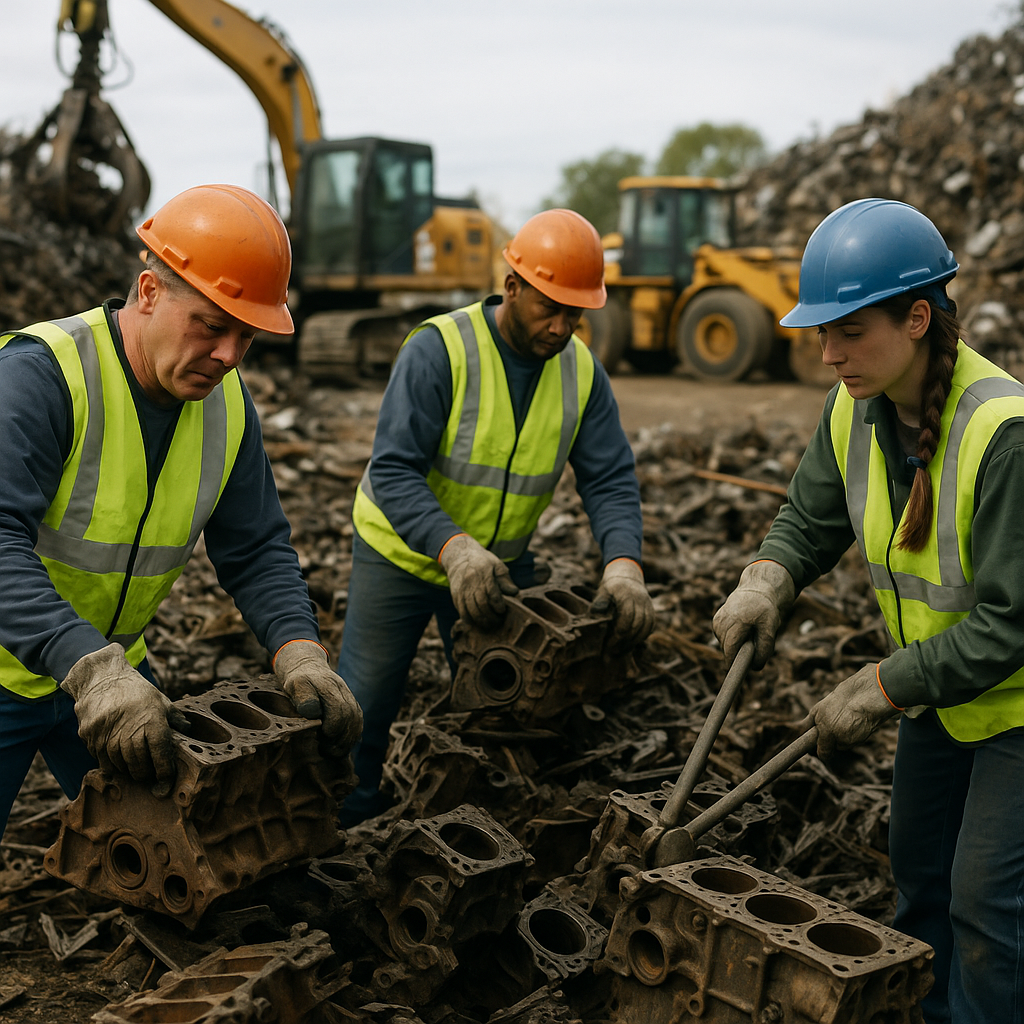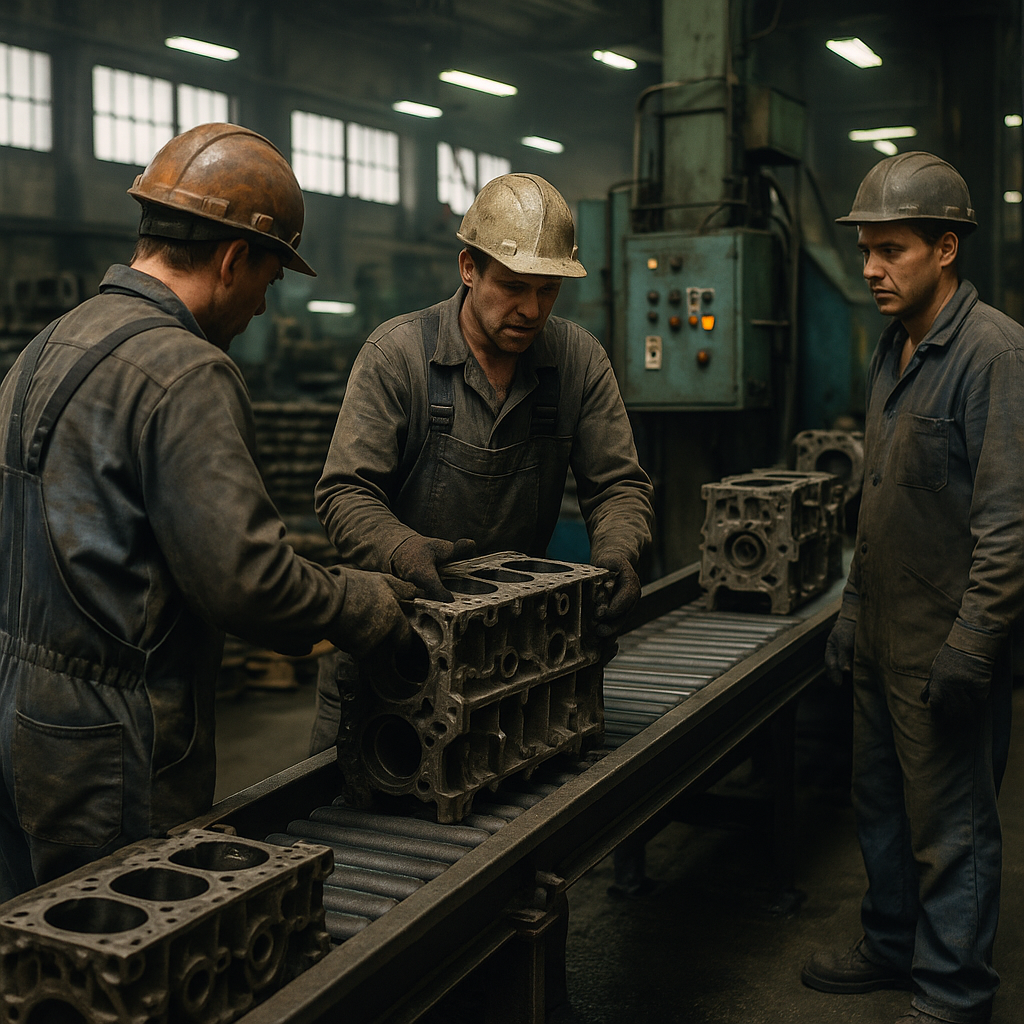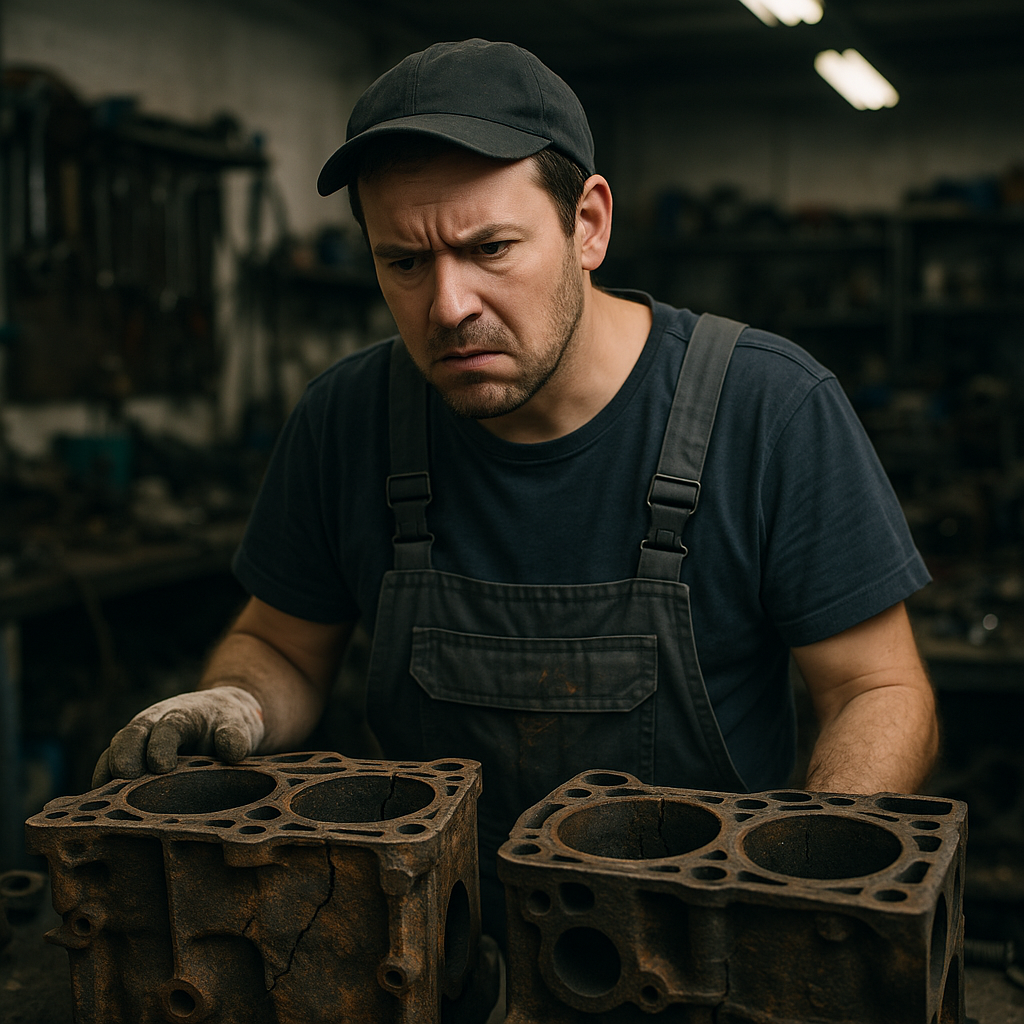5901 Botham Jean Blvd, Dallas, TX 75215
Scrap Engine Block Recycling Process: Collection, Processing Steps, Challenges, and Benefits
October 8, 2025Millions of vehicles reach the end of their useful lives each year. When scrapped, their engine blocks contain valuable metals that can be recovered and reused. The scrap engine block recycling process transforms these discarded components into worthwhile resources.
Engine blocks, typically made from cast iron or aluminum, are among the largest metal components in any vehicle. Recycling these blocks involves a systematic approach of collection, processing, and material recovery. This journey begins at salvage yards where discarded vehicles are dismantled.
The environmental benefits of engine block recycling are considerable. This process reduces the need for raw material extraction, decreases energy consumption, and minimizes waste sent to landfills. For example, a recycled aluminum engine block requires only 5% of the energy needed to produce a new one from raw materials.
How are Engine Blocks Collected and Sorted?

Engine blocks begin their recycling journey at scrapyards and recycling facilities after being removed from end-of-life vehicles (ELVs). Proper handling is essential to maximize their recycling potential and maintain material purity throughout the process.
The collection process starts when vehicles reach the end of their useful lives. Professional scrapyards remove engine blocks during vehicle dismantling. This careful extraction prevents contamination with other materials and preserves the value of these metal-rich components.
The Collection and Sorting Process
The journey from a discarded vehicle to recycled material includes several key steps:
- Fluid drainage – Technicians drain all fluids from the engine block, including oil, coolant, and fuel, to prevent environmental contamination.
- Component removal – Small parts like alternators, compressors, and ignition components are detached from the main block, as they contain valuable metals that require separate recycling processes.
- Preliminary cleaning – Surface dirt and impurities are removed to improve sorting accuracy and final material quality.
- Material identification – Technicians sort engine blocks based on their composition, primarily separating aluminum engine blocks from cast iron ones.
- Magnetic separation – Recyclers use magnets to differentiate ferrous (iron-containing) from non-ferrous metals, as ferrous metals stick to magnets while aluminum blocks do not.
- Further sorting – Additional methods like screening or airflow sorting help remove non-metal impurities.
Material purity is crucial during this process. Properly sorted and cleaned engine blocks can be processed more efficiently, reducing energy expenditure and environmental impact while preserving their value.
Why Proper Sorting Matters
The meticulous separation of engine blocks by material type serves several important purposes. Aluminum engine blocks command a higher recycling value than iron blocks due to aluminum’s lightweight properties and increasing demand in manufacturing. Mixing these materials would significantly reduce their value and recycling efficiency.
Cast iron engine blocks, commonly found in older vehicles, follow a different recycling path than their aluminum counterparts. The density and durability of cast iron make it ideal for applications in construction and manufacturing after recycling, but only when properly sorted from other metals.
The automotive recycling industry processes more than 12 million vehicles annually in the United States alone, with engine blocks representing a significant portion of the recoverable metals by weight. This volume highlights the importance of efficient collection and sorting systems in managing this valuable resource stream.
What are the Steps in Processing Scrap Engine Blocks?

Processing scrap engine blocks follows a systematic approach, transforming discarded automotive components into valuable recycled materials. The journey from scrap to reusable metal involves multiple critical stages that ensure maximum recovery and quality.
The first step is dismantling. This crucial phase involves removing all non-metallic components such as plastic covers, rubber hoses, and electrical parts. Technicians also drain any remaining fluids, like oil or coolant, to prevent environmental contamination and ensure safe handling during subsequent processing.
Once dismantled, the engine blocks move to the shredding phase. Industrial shredders or crushers break down the bulky blocks into smaller, manageable pieces. This size reduction makes the material easier to handle and increases surface area for more efficient melting. The shredding equipment uses powerful mechanical force to fragment the tough metal casings.
The melting process follows shredding. The fragmented engine blocks enter large industrial furnaces where temperatures exceed the melting point of aluminum (approximately 1,220 degrees Fahrenheit). For cast iron engine blocks, even higher temperatures are required. The intense heat transforms the solid metal fragments into a molten state, allowing for separation from heavier impurities.
Purification is one of the most technical stages in the process. Specialists remove impurities from the molten metal using methods such as fluxing, which binds contaminants to form removable slag, and degassing techniques that eliminate dissolved gases. This ensures the recycled metal meets quality standards for reuse.
The final major step is solidification. After purification, the molten metal cools and solidifies into standardized forms like ingots, bars, or sheets. This controlled cooling process must be carefully managed to prevent internal stresses and ensure uniform metal properties. These solid forms become raw materials for manufacturing new products, completing the recycling loop.
Through this multi-stage process, scrap engine blocks that would otherwise end up in landfills are transformed into valuable materials for new manufacturing applications. The process saves energy compared to producing metals from raw ore while diverting substantial waste from disposal sites.
What are the Challenges in Engine Block Recycling?

Engine block recycling faces several significant obstacles that require innovative solutions. Contamination is a primary challenge. Engine blocks often arrive with oil residue, coolant, rubber seals, and other attached components that must be removed before processing.
These contaminants can compromise the quality of recycled metal and potentially damage recycling equipment. The separation process is labor-intensive and requires specialized machinery, adding considerable cost to recycling operations.
Alloy separation presents another major hurdle. Modern engine blocks contain various aluminum alloys with different properties. These must be properly identified and separated to maintain material integrity. Mixing incompatible alloys results in lower-quality recycled materials with reduced market value.
The energy consumption involved in processing engine blocks raises both economic and environmental concerns. The melting process demands substantial energy input. High temperatures needed to process aluminum consume significant resources, impacting both the carbon footprint and operational costs of recycling facilities.
The automotive industry’s shift toward electric vehicles introduces new complexities. Electric vehicles contain fewer traditional engine components. This changing landscape means recyclers must adapt their processes and equipment. Many facilities are investing in new technologies to handle different material compositions.
Pre-treatment stages have become increasingly important. Manual sorting and cleaning remove large contaminants before mechanical processing begins. Advanced separation technologies such as eddy current separators and infrared sorting systems improve efficiency.
Despite these challenges, the industry continues to innovate. New processing methods allow for better recovery of valuable materials. Improved separation techniques reduce contamination levels, resulting in higher-quality recycled aluminum that can be used in more applications.
The economic aspects of engine block recycling also require careful management. Dirty aluminum generally commands lower prices than clean material. Additional processing steps necessary for contaminated engine blocks increase operational costs. Recyclers must balance these factors to maintain viable business models.
Environmental regulations add another layer of complexity. Proper handling of potentially hazardous materials from engine blocks requires compliance with strict guidelines. Facilities must invest in appropriate containment and disposal systems for contaminants removed during processing.
What are the Benefits of Engine Block Recycling?
Engine block recycling offers substantial environmental and economic advantages, significantly beyond simple waste reduction. The recycling process transforms potential landfill waste into valuable resources for manufacturing cycles.
Resource conservation is one of the primary benefits of engine block recycling. The EPA estimates that recycling one ton of steel conserves 2,500 pounds of iron ore, 1,400 pounds of coal, and 120 pounds of limestone. By reclaiming metals from discarded engine blocks, the need for extracting and processing raw materials is significantly reduced.
Energy efficiency presents another compelling advantage. Recycling aluminum, a key component in modern engine blocks, requires 95% less energy than producing new aluminum from bauxite ore. This leads to massive energy savings across the automotive industry. Steel recycling, also common in engine components, requires 60-70% less energy than producing new steel from virgin materials.
These energy savings directly contribute to significant reductions in emissions. According to industry research, recycling one ton of aluminum prevents approximately 9 tons of CO₂ emissions, while steel recycling reduces emissions by about 2 tons per ton processed. The recycling industry as a whole reduces greenhouse gas emissions by roughly 29 million tons of CO₂ annually, which is equivalent to removing 6.3 million cars from roads.
Economic benefits extend to both recyclers and manufacturers. Businesses can turn what was once considered waste into revenue streams by selling recyclable engine components. For manufacturers, using recycled materials offers stability against volatile raw material prices and lowers production costs. The Institute of Scrap Recycling Industries reports that using recycled steel can reduce production costs by up to 33% compared to virgin materials.
The recycling process creates more jobs than traditional disposal methods. Studies suggest that recycling activities generate up to 10 times more jobs than landfilling for equivalent material volumes. These roles span collection, processing, manufacturing, and administration, providing diverse employment opportunities.
Water conservation is another significant benefit. Traditional metal production from raw materials requires vast quantities of water for processing and cooling. Recycling dramatically reduces water usage, conserving this increasingly valuable resource.
Engine block recycling also prevents toxic materials from entering landfills. Metals like lead and mercury, which might be found in older engines, can leach into groundwater and soil if improperly disposed of. Recycling contains these potential toxins and converts them into valuable resources.
Importantly, engine block recycling supports the automotive industry’s sustainability goals and circular economy initiatives. Unlike many materials, metals can be recycled repeatedly without losing their essential properties, making them ideal for sustainable material cycles. This perfect circularity positions engine block recycling as a cornerstone of sustainable automotive practices.
Final Words
Engine block recycling stands as a crucial pillar of sustainable automotive manufacturing and environmental stewardship. By transforming discarded metal components into reusable resources, the industry not only conserves energy and raw materials but also minimizes pollution and waste. Each recycled engine block represents a tangible step toward a cleaner, more efficient circular economy where materials are continually repurposed rather than discarded.
As technology evolves and recycling processes become more advanced, the potential for reclaiming valuable metals from old vehicles will only continue to grow. Through continued innovation and responsible recycling practices, we can ensure that the automotive industry contributes to a greener future while maintaining economic efficiency and resource sustainability.
Call Okon Recycling at 214-717-4083 for all your recycling needs. Our team specializes in efficient metal recovery and environmentally responsible recycling solutions that make a real difference.
